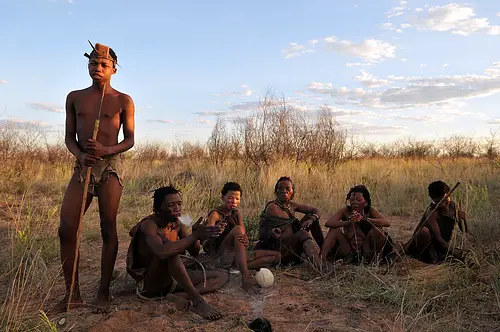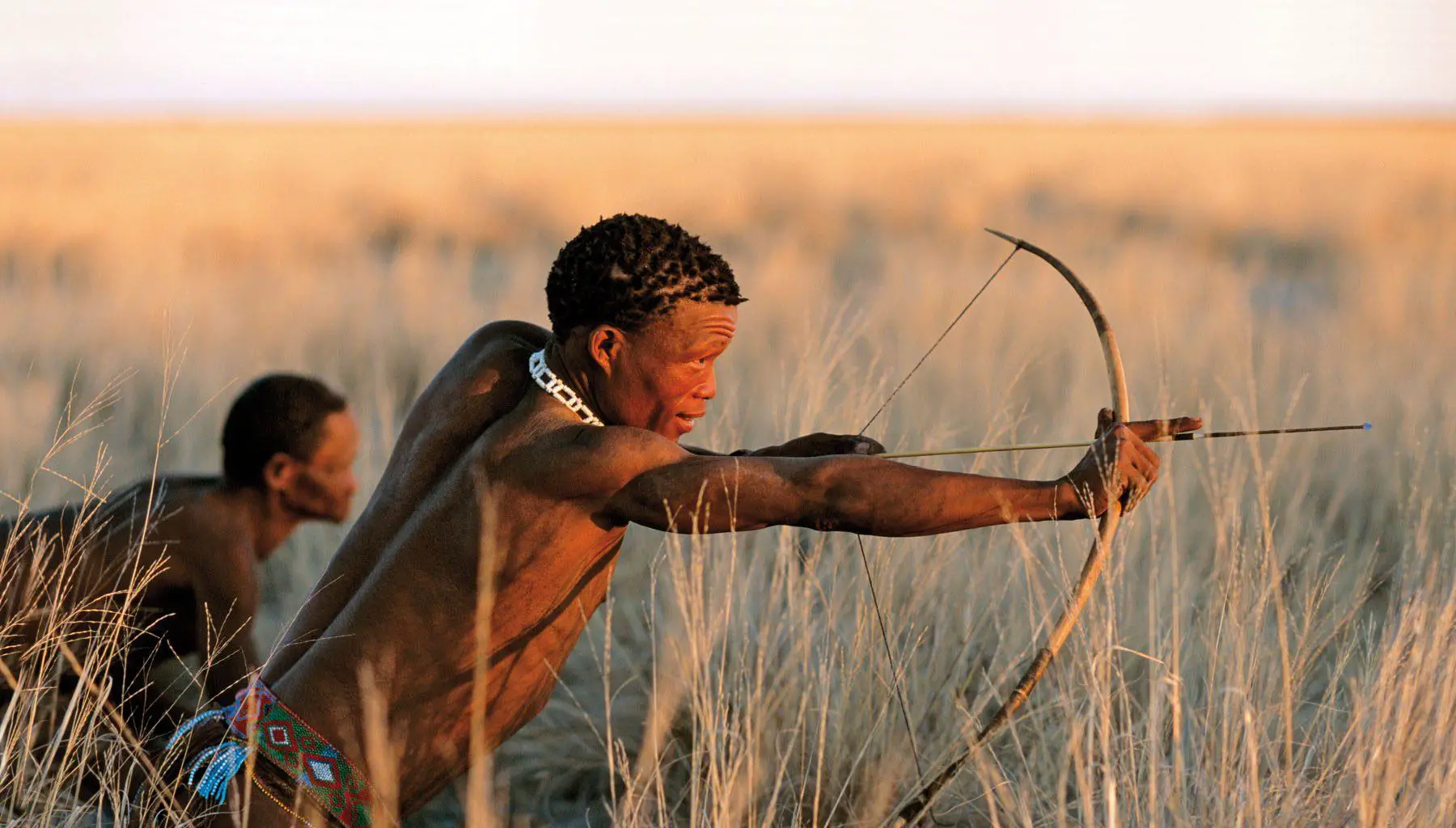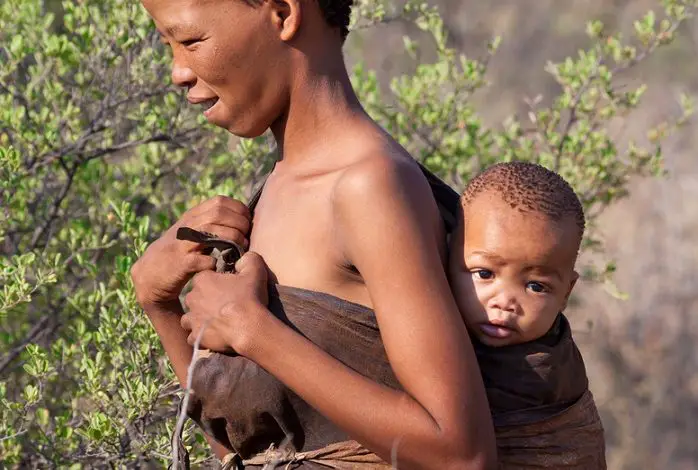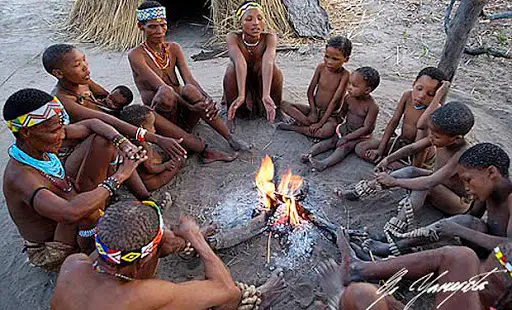The Little People of Kalahari Desert
Travel
The Kalahari Desert is a huge located in Southern Africa stretching 900,000 square kilometers. It is made up of semi-arid sandy savannah and covers much of Botswana and some parts of Namibia as well as South Africa.
Kalahari Desert, is a semi-desert and whenever it gets enough rain, there is a huge perfect grazing tracts, and these supports many animals as well as plants that cannot be found in a perfect desert such as the Namib Desert which is located in the west.
The Kalahari Desert is found in a region that is referred as to be subsidence within the Hadley cell, which are known as horse latitudes. It receives small amount of rainfall and during the summer seasons the temperature shoot to extreme levels. Normally it receives 3-7.5 inches of rain annually.
The surrounding Kalahari Basin extends over 2,500,000 square kilometers and moves further deep within Botswana, South Africa and Namibia, and almost gets into Zambia, Angola and Zimbabwe.
The Kalahari Desert as a single permanent river which is known as the Okavango, and the river waters flow within the delta in the northwest, creating marshes that are extremely populated with wildlife. There are ancient dry riverbeds which are known as omuramba to locals and can be found within the central north of the Kalahari Desert. These offer standing pools of water during the rainy season. There are different species of animals from giraffes to elephants, as well as predators such as cheetahs and lions. Currently the riverbeds are used as grazing spots. Somehow, the Kalahari Desert resembles some of the Australian deserts.

Within the Kalahari Desert there is a small population of people who are known as Bushmen. These are the oldest inhabitants of southern Africa and it is estimated that there have been living there for over 20,000 years. Kalahari Desert has been their home and they are not ready to leave it. Bushmen have remained to their roots and reflect the Africa’s oldest cultural group. These are the closest surviving people that are close to the original Homo sapiens the source from which is known to have led to the emerging of the negroid people of Africa. Bushmen are small with yellowish skin and form wrinkles at their early age. Due to the small physical body structure, that is the reason they are referred to as the little people of the Kalahari Desert.
Initially, the Bushmen lived in Southern Africa in the countries of Botswana, Namibia, Zambia, South Africa, Angola, and Zimbabwe. Their life entirely depended on hunting and gathering. But today there are virtually none that survive entirely by just hunting and gathering.
Bushmen people have a unique language despite the fact that bushmen people differ, but they do not have a collective name for themselves, and the names such as bushmen, san, basarwa and many other names are used by other people to refer them. But most people use the term bushmen to refer these people of the Kalahari Desert.
Historians think that all the bushmen are from the same heritage, but had become pastoralists even before the bantu tribe and the white farmers had come to Southern Africa. The term Khoisan is used as the academic term when referring to all bushmen who are found in southern Africa. Bushmen have varieties language that have a similar characteristic, which is click sounds which are represented on writing using symbols such as ! or /. The Khoisan languages use the unique clicks which vary and are complex because they consist of a lot of varieties as well as applications over different clans as well as groups.
Bushmen were initially gatherers and hunters where as their traditional diet contained about 70 to 80% of plant food which included berries, roots, nuts and melons that were normally collected by women. The remaining portion that covered about 20 to 30% was meat, especially antelope meat, which was hunted by men. Men used poisoned arrows as well as spears and went for hunting that could take even several days to kill an animal.
Bushmen made their temporary homes using wood that they collected. Their way of hunting and gathering economy as well as their social structure remained the same for tens of thousands of years, until recently when they started to undergo transition and started practicing agriculture. Initially the Bushmen never kept livestock and had no sense of ownership of land nor animal.
The Bushmen have to tribal social structure as they do no have paramount leadership and their kinship ties are fairly simple. They are normally loosely knit family culture where all the decisions are made based on universal discussion and agreement by consensus. Any individual’s opinion is normally valued in accordance to their experience and skill in the field in discussion.
Families that come from a similar clan may speak a common language while the neighboring clans might speak a different variety of language, despite the fact there is always a common degree of similarity and understanding between the clans. People from the same family bear the same name where there are only 35 names per gender, and they are allowed to foster a kinship name.
Bushmen are normally nomadic only within certain boundaries which are governed by proximity of clans as well as families. A family territory may extend to a 25 mile circle in case there are no other families or clans within that area the boundaries might extend further so as to ensure that there is enough food as well as sources of water.

Women and men roles are entirely different and they can rarely overlap, and this is almost universal when it comes to hunter/gathers all over the world. This is based upon the survival needs and it encourages the most efficient use of the resources and skills that are available.
Besides, Bushmen value so much women opinions especially when it comes to matters that are related to food.
Normally, Bushmen women spend about 3-4 days in a week collecting roots, fruits and berries. They do that by going out in groups searching for edible or medicine plants. Before they had any contact with the bantu or white settlers, everything they used was made up of plants and animal products including tools and weapons. More than 400-500 local plants as well as their uses were well known to bushmen, and they knew the places where they grew so that they can easily locate them. This helped them in getting a balanced nutrition, as well as moisture from roots especially in drought periods.
Plants were normally used in a way similar to the Western phytomedicine in order to treat wounds as well as heal illness. Other plants were used in healing ceremonies in which a healer had to burn plants so as to create rain, or perform a charm so as to bring fertility. The extent of ailments treated consisted of wounds that came from snake bites, stomach ache, colds, tooth ache as well as head ache or diarrhea. Besides, infections such as tuberculosis, malaria, and syphilis. One of the bushman plant that is known as Hoodia gordonii hit the world by storm as it was patented by a pharmaceutical company as being a diet support due to being used by the bushmen as a traditional drug of suppression appetite as well as hunger.
Their lifestyle as well as diet have kept them from most of the stress related diseases that face the western world. The fact is that their health is not good as 50% of children die before reaching the age of 15, while 20% die within their first year due to gastrointestinal infections. Their average life expectancy ranges between 45-50 years. They are normally facing respiratory infections as well as malaria which is the main causatives of deaths in adults. Just 10% reach the age of above 60 years.

Giving birth when it comes to Bushmen is not a big issue at all. They do not make any preparation or go to the hospital just like how modernized people do. A bushman woman who is about to give birth will just go behind the bus and squeeze the baby out. There are also claims that they do prepare medicine from the plant that is known as the devil claw (Harpagonphytumspp). A soon as the woman as had the baby, she gets back to her daily routines within an hour. But when she is having a baby she is likely to go with her mom or elderly aunt to help with the whole process.
Sometimes the child birth giving process does no go easy as it should. It might come with some complications and therefore someone who has to offer help should be around. When the baby is born, they receive much love and attention from the parents as well as other adults. Bushmen have somuch love for their children and the children of other people.
In case the baby is born under extreme drought conditions, when the fertility of the Bushmen females are extremely low at the time, in order to prevent the baby from the drought sufferings the mother will quietly end the baby’s life so as to prevent it from the suffering. This is likely to happen I lean years in case she is still suckling another child and she has no ability of feeding them both. This is done if the baby is born out of necessity and not malice or any other consideration.
For the Bushmen, death is just a natural thing and can be noted in certain lines in their ceremonial songs. When of the line in one of their songs says that, “The day we die a soft breeze will wipe out our footprints in the sand. When the wind dies down, who will tell the timelessness that once we walked this way in the dawn of time?”
In case one dies at a particular camp, the Bushmen will move away and never camp again on that particular spot. Besides Bushmen will never ever cross a place where they buried someone. In case they are forced to pass near the place, then they will throw a pebble upon one’s grave and mutter under their breath, to the spirits as a way of ensuring good luck. Besides they will never step upon the grave and they do believe that the spirit remains active on that same spot at the top of the ground, and they would do anything never to offend it.
Most of the Bushmen, when it comes to wedding, that is a private even between the bride and bridegroom. With exceptional cases, that is where a guest might be invited, but normally there is no celebration nor other ritual during marriage. It is just an agreement between the two people who are involved.
Besides, Bushmen have no initiation ceremonies. They have some dancing as well as cleansing ceremony soon after a maiden gets her first menstrual blood. Boys are never considered men until they kill their first dangerous animal. When they do that, that is when they are treated as grown up members of the tribe or clan.

Today there are many problems facing Bushmen and it all started when the Bantu tribes led their cattle into the Bushmen homelands from around 1500 years ago, and also the white colonialists did the same even though they have left for over a hundred years ago. Ever since that time, Bushmen have undergone discrimination, eviction from their ancestral homelands, murder as well as oppression that keeps getting serious and that has reduced their population from several millions to just 100,000 today.
Despite the fact they face discrimination as many of the invaders argue that their lifestyle s so primitive and they should change and start living like the majority cattle herding tribes, specific problems differ depending to where they live. For example in South Africa, the !Khoman rights to their land have been recognized, while many other Bushmen have no rights over their ancestral lands at all.
A huge number of Bushmen known as the Ju/’hoansi, currently live on both sides of the Namibia and Botswana boarders. This location is known as the Bushmanland. This Bushmen community has been studied, filmed, and assisted by Western scholars since where back, dating 1951 to date.
The community is still allowed to hunt within the boundaries, even though the place is a game reserved area, but they have been given that right only if they will just do that using traditional methods. This means that they are not allowed to use dogs, vehicles, firearms or horses. These rules are normally broken and this has led to prison sentences to the defenders.
One of the major broblems is alcoholism which is brought around by the military that has been stationed along the local town of Tsunkwe. The military personnel bring alcohol to the region despite the fact that the government has banned anyone from bringing in spirits. Due to alcoholism, there came a massive drunkenness, crimes and fall in family structures as well as community wellbeing.
The Gana (G//ana) as well as the Gwi (G/wi) tribes that are found in Botswana within the Central Kalahari Game Reserve are the most marginalized. Despite the fact that they right to the land ownership has been denied after living in the place for thousands of years, the government of Botswana has in fact forced almost all of them out of their land.
This came in the early 1980’s where diamonds were discovered within the reserve. As soon as this happened the government authorities rushed to the reserve to inform the Bushmen living in that particular area that they would have to leave the place. Three big clearances took pace in 1997, 2002, and 2005, where almost the entire Bushmen communities were forced out of their ancestral land. Their homes were taken down while their homes as well as health posts were shut down. The government went on to destroy their water sources and they were threatened and carried away off the reserve.
No matter of what the government did, many of them have returned while others are still willing to do so. Currently they live in resettlement camps which are located off the reserve where they are rarely able to hunt as when they are caught hunting they are caught and beaten. They are currently facing alcoholism, and diseases such as TB and HIV/Aids.
Despite the fact that Bushmen took a case to court with the help of a British lawyer, and worn against the government, but But until today the Botswana government has done everything to prevent them from returning back to their ancestral home. The government still arrests any bushman who tries to hunt or live within the reserve.
Hundreds of them have been arrested for hunting to feed their families, while the government has banned Bushmen from using their water borehole. Their problems seem that will never end unless they are allowed to return to their ancestral homeland.
There are different measure taken by local and international organization to make sure that these marginalized communities are given their rights. But the battle is still on and we hope that one day they will able to win their land back.
These are the small people of the Kalahari Desert.

Mwijage Prince